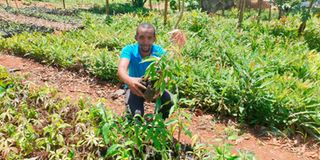Agricultural co-ops must innovate so as to attract youth into farming

A young man, Eric Mugendi, works on his seedling farm in Siakago, Embu County.
The “Economic Survey 2016” report says agriculture employs over 70 per cent of Kenya’s rural population and contributes 30 per cent of gross domestic product and 27 per cent indirectly.
But the country’s food production is dwindling. A contributing factor is the ageing farmer, who are averagely aged 61, yet over 75 per cent of the population is under 35! Engaging the youth could cure food insecurity.
Due to reduced agricultural output, basic food imports are increasing. With the scenario replicated across Africa, it could spend more of its foreign exchange on food imports. According to the African Development Bank (AfDB) president, Dr Akinwumi Adesina, Africa’s annual food import bill of $35 billion (Sh4 trillion) will rise to $110 billion by 2025.
The rural-urban push-pull factors—such as low profitability from farming, poor land tenure security and high risks of agricultural ventures—could cause a farmer shortage in Africa. To nudge tech-savvy youth into farming, agricultural cooperatives must spearhead technology-driven farming practices. They would bring energy, vitality and innovation into the new agricultural enterprises.
But the Kenya Youth Agribusiness Strategy (2018-2022) identifies several hindrances to that. Most consider agriculture as a venture with sporadic low returns, seasonal and risky. The negative perception is reinforced by parents and teachers, who often use farm labour as punishment and an alternative for academically underperforming students.
Affordable financial services
Limited access to both land, the principal resource in agriculture, and affordable financial services are another factor. Due to exposure to multiple external shocks, agriculture is considered risky by financiers.
Also, the traditional farming and produce storage techniques are labour-intensive and often result in low productivity due to declining soil fertility, low adoption of modern technologies, inefficiencies in production due to low rate of mechanisation, high post-harvest losses, pest and disease outbreaks, limited access to inputs and services, poor management and inadequate skills.
Other challenges include limited value addition, domestic processing and access to markets, policies that don’t support youth in agri-preneurship, and climate change. With cross-cutting challenges like gender and cultural barriers, disability and weak governance, the odds are stacked against youth.
Enacting appropriate regulatory frameworks by the government would give agricultural cooperatives the opportunity to lead farmers into technology-driven production systems. Agricultural cooperatives could also collaborate with universities to recruit more youth into agriculture as a career.
Recommendations of a 2012 International Fund for Agricultural Development (Ifad) meeting included that cooperatives become youth-sensitive, particularly in representation and governance, and gender inequalities addressed to include young women.
Advisory services
Secondly, they provide mentoring, guidance and advisory services to young members to become leaders and farmer entrepreneurs. Thirdly, they value indigenous or traditional agricultural knowledge and practices while promoting innovations to attract the youth.
Fourth, cooperatives, donors and governments formulate and implement youth-focused agricultural development projects and programmes to raise the profile of the sector. Fifth, cooperatives are a platform for sharing and demonstrating farmers’ success stories or linking youth to agricultural institutions.
Lastly, donors and governments provide specific financial support for the development of cooperatives that involve and/or engage with youth. It has been a decade since.
Low-income countries have been pushed into a corner. But the FAO director-general says low-income countries where agriculture is key to the economy, jobs and rural livelihoods have little public resources to repurpose. We must innovate to attain the 2030 global nutrition targets. As a leader in the cooperative movement in Africa, Kenya should lead the way in these reforms.
Prof Nyamongo, an anthropologist, is a deputy vice-chancellor at The Cooperative University of Kenya. [email protected]. @Prof_IKNyamongo





